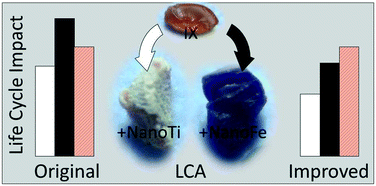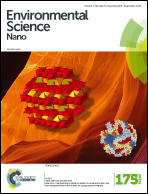Reducing environmental impacts of metal (hydr)oxide nanoparticle embedded anion exchange resins using anticipatory life cycle assessment†
Abstract
Nanocomposite sorbents are an emerging technology for drinking water treatment of multiple pollutants. Here, we used anticipatory life cycle assessment to proactively guide sustainable development of nanocomposite sorbents by comparing synthesis methods and treatment options, identifying critical steps in deployment, and reducing the environmental and human health impacts such that they become favorable over the existing technology of using two different materials in a mixed bed (MB). We studied iron (hydr)oxide or titanium dioxide nanoparticles precipitated in anion exchange resins (Fe-AX and Ti-AX) for targeted removal of chromium and arsenic. The Ti-AX had the lowest environmental and human health impacts compared to Fe-AX and MB for all nine impact categories studied. The synthesis phase for each sorbent contributed 50–100% of the total impacts. The greatest opportunity to improve Ti-AX synthesis was reducing oven heating time for nanoparticle hydrolysis. Reducing from 24 to 4 hours did not significantly change sorbent capacity but reduced impacts by 3–31%. Fe-AX synthesis was improved by increasing pollutant removal capacity to require less sorbent to treat the functional unit. This reduced impacts by 26–42%, making it favorable or equal to MB for six of the nine categories. Future development of nanocomposite sorbent synthesis methods should focus on optimizing sorbent capacity, decreasing heating energy demand, and efficiently reusing metal precursors and solvents. This study showed that the benefits of treating drinking water involve environmental and human health tradeoffs and that treatment impacts are on the same order of magnitude as distribution pressurization.

- This article is part of the themed collection: Sustainable Nanotechnology Organization 2015


 Please wait while we load your content...
Please wait while we load your content...